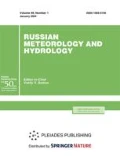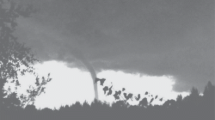Abstract
The characteristics of the сumulonimbus cloud with waterspout that has passed over the Gulf of Finland are analyzed. The characteristics were obtained from polarimetric Doppler weather radar, radiometer, and lightning detector data. The waterspout was formed close to the cyclone center. The analysis of instability indices revealed high atmospheric instability. The sinking of the rotational motion in the cloud before the waterspout generation is shown. The radar characteristics of the cloud at the moment of waterspout observation are considered in detail. It is concluded that good identifiers for the waterspout detection are the “Zdr column” and the zone in the lower part of the cloud with differently directed values of Doppler velocity and with the high values of velocity spectrum width.



Similar content being viewed by others

REFERENCES
Temporary Methodological Instructions on Using DMRL-C Doppler Weather Radar Data in Synoptic Practice, 2nd ed. (Roshydromet, Moscow, 2017) [in Russian].
R. J. Doviak and D. S. Zrnic, Doppler Radar and Weather Observation (Gidrometeoizdat, Leningrad, 1988) [Transl. from English].
M. A. Novitskii, Yu. B. Pavlyukov, B. Ya. Shmerlin, S. V. Makhnorylova, N. I. Serebryannik, S. A. Petrichenko, L. A. Tereb, and O. V. Kalmykova, “The Tornado in Bashkortostan: The Potential of Analyzing and Forecasting Tornado-risk Conditions,” Meteorol. Gidrol., No. 10 (2016) [Russ. Meteorol. Hydrol., No. 10, 41 (2016)].
A. A. Sin’kevich, T. W. Krauss, A. S. Ghulam, and A. B. Kurov, “Investigation of High-depth Cumulonimbus Clouds Characteristics after Seeding to Increase Precipitation,” Meteorol. Gidrol., No. 9 (2013) [Russ. Meteorol. Hydrol., No. 9, 38 (2013)].
A. V. Chernokulsky, M. V. Kurgansky, D. I. Zakharchenko, and I. I. Mokhov, “Genesis Environments and Characteristics of the Severe Tornado in the South Urals on August 29, 2014,” Meteorol. Gidrol., No. 12 (2015) [Russ. Meteorol. Hydrol., No. 12, 40 (2015)].
A. V. Chernokulsky, M. V. Kurgansky, and I. I. Mokhov, “Analysis of Changes in Tornadogenesis Conditions over Northern Eurasia Based on a Simple Index of Atmospheric Convective Instability,” Dokl. Akad. Nauk, No. 6, 477 (2017) [Dokl. Earth Sci., No. 2,477 (2017)].
H. B. Bluestein, M. M. French, R. L. Tanamachi, S. Frasier, K. Hardwick, F. Junyent, and A. L. Pazmany, “Close-range Observations of Tornadoes in Supercells Made with a Dual Polarization, X-band, Mobile Doppler Radar,” Mon. Wea. Rev., 135 (2007).
D. J. Bodine, R. D. Palmer, and G. Zhang, “Dual-wavelength Polarimetric Radar Analyses of Tornadic Debris Signatures,” J. Appl. Meteorol. Climatol., 53 (2014).
V. N. Bringi and V. Chandrasekar, Polarimetric Doppler Weather Radar: Principles and Applications (Cambridge University Press, 2001).
R. Evaristo, T. Bals-Elsholz, A. Stepanek, B. Wolf, K. Goebbert, A. Lyza, and T. Elless, “Polarimetric Radar Observation of a Tornado at C-band,” in Proceedings of the 35th Conference on Radar Meteorology (Pittsburgh, USA, 2011).
T. Inoue, “A Cloud Type Classification with NOAA 7 Split-window Measurements,” J. Geophys. Res., No. D4, 92 (1987).
M. R. Kumjian, “Principles and Applications of Dual-polarization Weather Radar. Part I: Description of the Polarimetric Radar Variables,” J. Operational Meteorol., No. 19, 1 (2013).
M. R. Kumjian, “Principles and Applications of Dual-polarization Weather Radar. Part II: Warm- and Cold-season Applications,” J. Operational Meteorol., No. 20, 1 (2013).
M. R. Kumjian and A. V. Ryzhkov, “Polarimetric Signatures in Supercell Thunderstorms,” J. Appl. Meteorol. Climatol.,47 (2008).
B. D. Lee, B. F. Jewett, and R. B. Wilhelmson, “The 19 April 1996 Illinois Tornado Outbreak. Part II: Cell Mergers and Associated Tornado Incidence,” Wea. Forecast., 21 (2006).
S. Lim, V. Chandrasekar, and V. N. Bringi, “Hydrometeor Classification System Using Dual Polarization Radar Measurements: Model Improvements and In Situ Verification,” IEEE Trans. Geosci. Remote Sens., 43 (2005).
A. V. Ryzhkov, T. J. Schuur, D. W. Burgess, and D. S. Zrnic, “Polarimetric Tornado Detection,” J. Appl. Meteorol., 44 (2005).
M. Sioutas, W. Szilagyi, and A. Keul, “Waterspout Outbreaks over Areas of Europe and North America: Environment and Predictability,” Atmos. Res., 123 (2013).
M. S. Van den Broeke and C. A. Van den Broeke, “Polarimetric Radar Observations from a Waterspout-producing Thunderstorm,” Amer. Meteorol. Soc., 30 (2015).
ACKNOWLEDGMENTS
The authors thank A. Sarkisova who recorded and posted the video files with waterspouts in the Internet and allowed using them for the present research (https://www.instagram.com/p/BmYmsqkFTNl/, accessed on December 17, 2018).
Funding
The research was supported by the Russian Foundation for Basic Research (grants 17-05-00965_a, BRIKS_t 18-55-80020) and by the grant 2018YFE0101200 (China).
Author information
Authors and Affiliations
Corresponding author
Additional information
Russian Text ©The Author(s), 2020, published in Meteorologiya i Gidrologiya, 2020, No. 9, pp. 5-16.
About this article
Cite this article
Popov, V.B., Sin’kevich, A.A., Yang, J. et al. Characteristics and Structure of the Cumulonimbus Cloud with Waterspout over the Gulf of Finland. Russ. Meteorol. Hydrol. 45, 607–614 (2020). https://doi.org/10.3103/S1068373920090010
Received:
Revised:
Accepted:
Published:
Issue Date:
DOI: https://doi.org/10.3103/S1068373920090010



